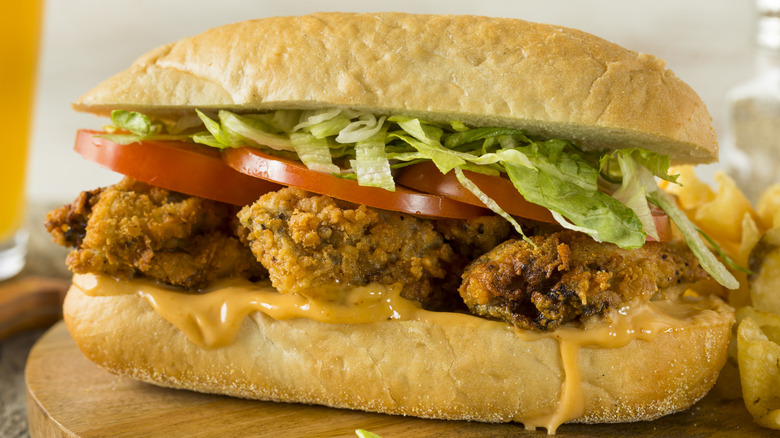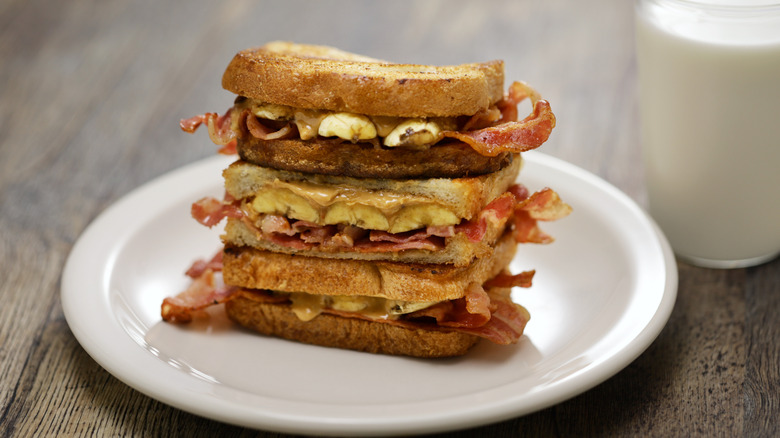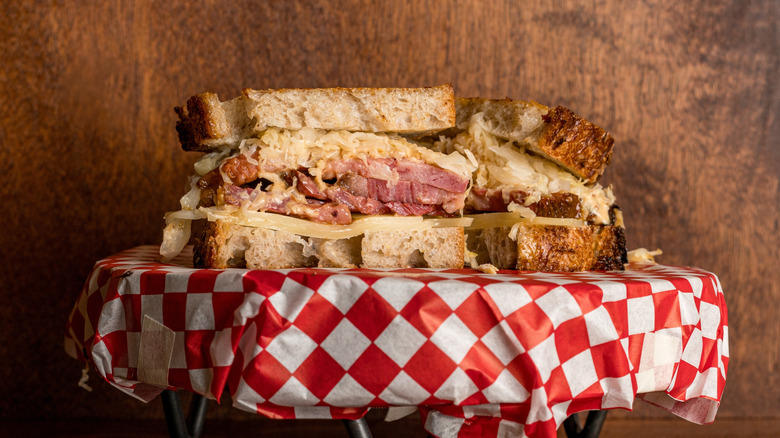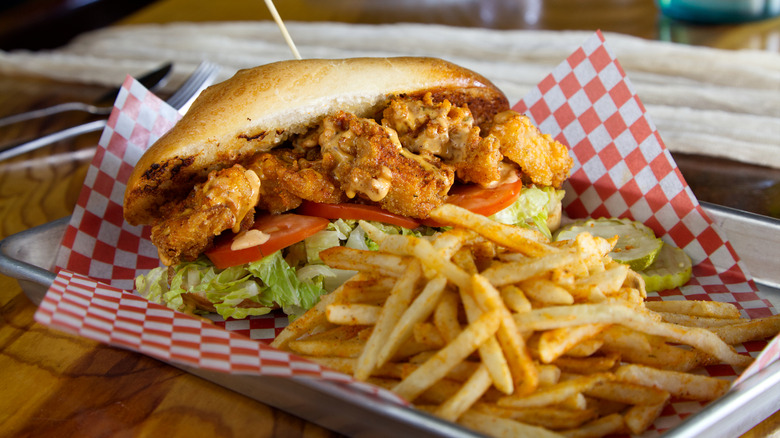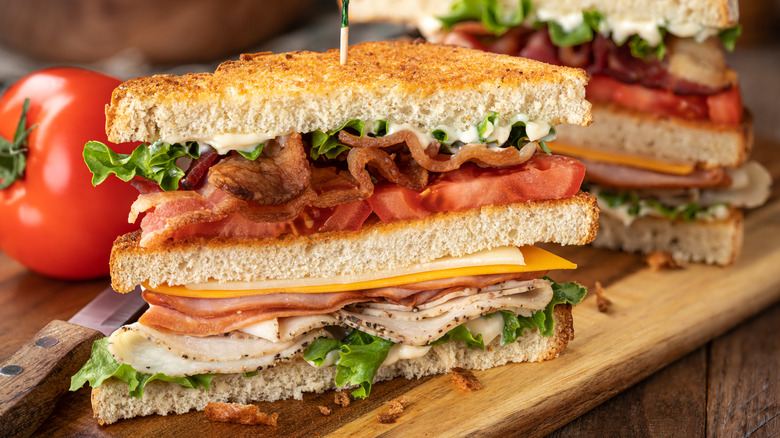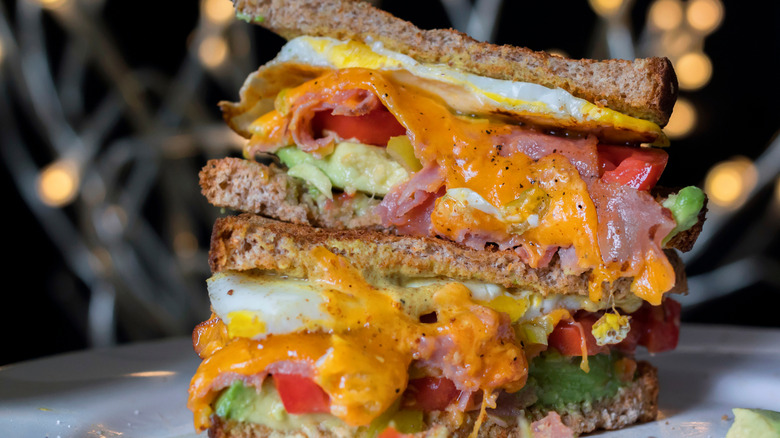How Did Our Favorite Sandwiches Get Their Names?
We may receive a commission on purchases made from links.
You can't name a sandwich Fluffernutter without a good reason. Just like you can't call a sandwich The Elvis without an honorable explanation for its association with The King. Yet we're usually so busy stuffing our faces with our favorite ingredients stacked between two slices of bread that we rarely question the history behind these classics.
But if we did, we'd find their stories are mythical, outlandish, historical, and sometimes literally comical. And so, welcome to Sandwich Semantics 101 — a basic lesson in how famous sandwiches were named.
The Elvis
What it is: Peanut butter, sliced or mashed banana, and (sometimes) bacon between two slices of toasted bread.
Name inspiration: Elvis Presley
How The Elvis got its name: What do you do when you're in hanging out with friends in Tennessee and start craving a sandwich only made in Colorado? If you're the King of Rock and Roll, you head to the airport, jump in your private jet, and fly there.
On February 1, 1976, musical icon Elvis Presley had a hankering for a sandwich he had enjoyed a month earlier in Glendale, a Denver suburb more than 1,000 miles from Memphis. Called the Fool's Gold Loaf, it was made by the Colorado Gold Mine Company Steakhouse and consisted of a whole loaf of bread warmed, hollowed out, and stuffed with peanut butter, jelly, and bacon. True to its name, it was not cheap — just one carried a price tag of $49.95.
Elvis, via phone, ordered 22 sandwiches (plus a case of Perrier and a case of Champagne, as one does), hopped in his private jet with his entourage, and was served by restaurant owners Buck and Linda Scott in a private hangar upon arrival at the Denver airport.
Reports vary about whether or not the original Fool's Gold Loaf included banana, but banana-and-peanut-butter sandwiches remained a favorite food of Elvis' up until his death in 1977.
Hot Brown
What it is: An open-faced sandwich of turkey and bacon drenched with Mornay cheese sauce, then baked until the cheese begins to brown and crisp.
Name inspiration: The Brown Hotel
How the Hot Brown got its name: History has an explanation for why this sandwich sounds like a gross euphemism you'd find on Urban Dictionary: it originated at The Brown Hotel in Louisville, Kentucky. The chef there, Fred K. Schmidt, introduced two specialty sandwiches shortly after the hotel opened in 1923.
One sandwich survived history, and one did not. The open-faced Cold Brown consisted of baked chicken or turkey, lettuce, tomato, and hard-boiled egg on rye bread and was topped with Thousand Island dressing. You are not the only one who's never heard of it.
The also open-faced Hot Brown, on the other hand, became legendary. According to "The Kentucky Encyclopedia," edited by John E. Kleber, the original Hot Brown used sliced roast turkey on white toast, topped with Mornay sauce, sprinkled with Parmesan, broiled, and garnished with bacon and pimiento. It was Chef Schmidt's posh alternative to traditional late-night fare — ham and eggs — and it became the hotel's most popular dish.
The Brown Hotel is still open today, still serves the Hot Brown, and even made the recipe available, in a quite democratic fashion, on its website.
Reuben
What it is: Corned beef, Swiss, sauerkraut, and Russian dressing between two slices of rye bread, grilled.
Name inspiration: Arguably someone named Reuben
How the Reuben got its name: There are three claims to The Reuben's name.
First, German emigrant Arnold Reuben is reported to have introduced the sandwich at his New York deli in 1914 after making it for actress Annette Seelos, who was particularly hungry one day.
A second story claims the sandwich originated at Blackstone Hotel in Omaha, Nebraska, where it was served — with the same ingredients we love today — to a group of poker players. This account suggests a grocer named Reuben Kolakofsky thought up the sandwich, which was so loved by Blackstone Hotel owner Charles Schimmel that he put it on the menu and named it for its inventor. A former waitress later entered the sandwich into a national competition in 1956 and won, further popularizing it.
And the final origin story takes us to Lincoln, Nebraska, in 1937, when the Cornhusker Hotel supposedly introduced it to the world for the first time. This particular claim actually has evidence: A Cornhusker Hotel menu from 1937 features the Reuben as we know it today, giving this claim tangible credibility.
Po'boy
What it is: Typically fried seafood (often shrimp or oysters) or roast beef on flaky, buttery French bread, "dressed" or "undressed."
Name inspiration: Transit strikers in 1929
How the po'boy got its name: The most widely accepted story behind the famous po'boy's name begins with brothers Bennie and Clovis Martin. They had worked as streetcar conductors in New Orleans before opening a coffee and sandwich shop in the French Market in 1922.
There, they served dishes like gumbo and red beans and rice with the chopped-off, narrow ends of French bread, and used the mid-section of those loaves for sandwiches. This became an issue, however, when customers started ordering more sandwiches. Too many sandwich orders meant too many unused bread ends. What to do? To solve the problem, the Martins collaborated with their bread supplier, the John Gendusa Bakery, to create an extra-long loaf that became a staple of the "poor boy loaf."
As for the name: When transit workers went on strike in 1929, the city of New Orleans rallied behind them, and the Martins were no different. They sent a letter to the streetcar workers' union to which they had once belonged, promising "our meal is free to any members of Division 194" and fed the men free sandwiches for several months until the strike ended.
"Whenever we saw one of the striking men coming, one of us would say, 'Here comes another poor boy,'" Bennie Martin recalled in "New Orleans Cuisine: Fourteen Signature Dishes and Their Histories."
Club sandwich
What it is: Sliced, cooked poultry, plus bacon, lettuce, tomato, and mayo on (sometimes toasted) bread, often cut into quarters or halves and held together by toothpick.
Name inspiration: Exclusive clubs that served it
How the club sandwich got its name: If you fell for the internet's lies that the "club" is actually an acronym, we're here to correct you. Despite what Twitter may have you believe, "club" does not stand for "chicken and lettuce under bacon." It's simply named for the (many) men's social clubs that claim to have invented it.
No one knows exactly who deserves the credit for the creation also known as the "clubhouse," but the Saratoga Club is an oft-mentioned possibility. The hotel and casino opened in 1894 in Saratoga, New York, and has been credited by sources including The New York Times with the sandwich's creation.
Another fun fact: Food experts and historians swear the original version only used two slices of bread, not three. James Beard described the three-slice version as "a horror" in his 1972 book "American Cookery." And Anthony Bourdain had similar feelings, as he shared in his cookbook, "Appetites." Maybe we've been doing it wrong this whole time. (Incidentally: The name of the middle bun in a Big Mac? You guessed it: the club.)
Dagwood
What it is: A tall, multilayered sandwich made with various meats, cheeses and condiments.
Name inspiration: A comic strip character
How the Dagwood sandwich got its name: Let's flash back to a time when memes didn't exist, but comic strips did. Specifically, we're talking about "Blondie," a comic strip about a beautiful flapper girl named Blondie and her many boyfriends, including Dagwood Bumstead. Dagwood had a habit of making gargantuan sandwiches from leftovers in the fridge. (Boyfriend goals, amiright?) Imagine the biggest sandwich you've ever ordered from the most amazing Jewish deli you've ever been to and multiply the size of that sucker by three. That's a Dagwood, named for its fictional inventor.
It's hard to tell exactly what ingredients were illustrated in Dagwood's sandwiches, but one thing's for sure: It involved tons of different cold cuts, cheeses, and veggies, with extra slices of bread throughout. Stick an olive-adorned toothpick through the center of your skyscraper of a sandwich, and you have yourself a Dagwood.
Muffuletta
What it is: A muffuletta loaf filled with layers of mortadella, ham, Genoa salami, mozzarella, provolone, and olive salad, served cold.
Name inspiration: The specific bread it uses
How the muffuletta sandwich got its name: The reason for the muffuletta's name is simple, yet few people know it: It's all about that bread. The New Orleans classic known for its signature olive spread also has a signature bread called the muffuletta.
According to "The Oxford Companion To American Food And Drink," the original muffuletta sandwich was made on this specific bread, a wide, round, crusty loaf about 10 inches across with a crispy, sesame seed-covered exterior and soft, doughy interior. It was created around 1895 by an Albanian baker from Palermo, Sicily, where at least one bakery still makes it today.
Bonus muffuletta trivia: The sandwich can be credited to Italian immigrants who moved to New Orleans in the early 1900s and worked in the French Quarter's bustling food industry. Signor Lupo Salvadore, a Sicilian immigrant himself, noticed other Italian workers in the French Quarter using the broken olives removed from barrels as a spread on the bread they brought for lunch — and thus the muffuletta was born.
